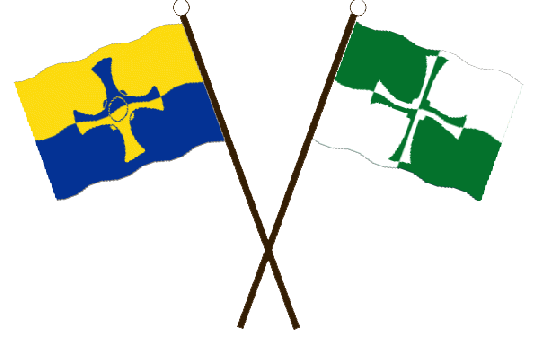Shortly after the adoption of the county flag, which features the famed pectoral cross of Saint Cuthbert, a vote was held to select a date for celebration as County Durham Day. The winning date was the date of the saint’s death, March 20th.
Cuthbert

was born in Dunbar, then in Anglo-Saxon Northumbria

in about the year 635, the year that the monastery on Lindisfarne

was founded. His birth came less than ten years after King Edwin of Northumbria had embraced Christianity in 627, followed slowly by the rest of his people. Times were violent and episodes of pagan rule ensued, the task of spreading the Christian message endured through Cuthbert’s lifetime.
Of supposed noble origins, as a boy he learnt the arts of war and it is believed that as a teenager he fought in at least one battle. The course of his life is believed to have changed, when, aged seventeen, he said to have spied a light drop to Earth and then return to the sky. This was the night that the Irish missionary Aidan, who had established Lindisfarne, died and believing that the light was the passage of a human soul, Cuthbert resolved to join the monastery at Melrose, which Aidan also founded and asked to be admitted as a Novice. He was appointed guest-master at the new monastery at Ripon, then in about 662 prior at Melrose. In 664 the Synod of Whitby decreed that Northumbria should look to Rome for spiritual guidance, rather than Ireland; the Irish monks returned to Iona and the abbot of Melrose subsequently became also abbot of Lindisfarne and Cuthbert its prior. He is thought to have lived there for the next ten years. He ran the monastery and was an active missionary, much in demand as a spiritual guide. He is also said to have developed the gift of spiritual healing. Reputedly outgoing, cheerful and compassionate, he was likely very popular but at about the age of forty, he felt a calling to be a hermit, to fight the spiritual forces of evil in a life of solitude. In time he moved to the island known as ‘Inner Farne’ and built a hermitage where he lived for a further ten years, although it seems people frequently visited in little boats to consult him or ask for healing!
When aged about fifty, in 684, his circumstances changed again when requested by both Church and King to become Bishop of Linidsfarne. Agreeing reluctantly, he was for about two years an active, travelling bishop, apparently journeying extensively. One story holds that he was visiting the queen, Eanflæd in Carlisle, far from Lindisfarne, when he sensed by “second sight” that her husband King Ecgfrith,

had been slain by the Picts doing battle in Scotland.

Owing to ill health he resigned his position in 686 and retired back to his “Inner Farne” hermitage where he died on March 20th 687.
After his death he became one of the most important medieval saints of England, with a cult centred at Durham Cathedral, where his remains were eventually interred and he is generally regarded as the patron saint of northern England. When his coffin was last inspected on 17 May 1827, a typical Anglo-Saxon, square pectoral cross of gold, with splayed ends

and studded with garnets, was discovered, buried amongst the robes on the body.
Cuthbert’s Cross features on both the flag of County Durham and that of the Scottish county of Kirkcudbrightshire, named for the saint.

St Cuthbert’s Society, a college of Durham University established in 1888, is named after him and is located only a short walk from the coffin of the saint at Durham Cathedral. The Society celebrates St Cuthbert’s Day on or around each 20th of March with a magnificent feast. “Cuth’s Day”, the annual college day, is celebrated in the Easter term with music, entertainment, festivities and drinking. Cuddy’s Corse is a waymarked walking route between Chester-Le-Street and Durham Cathedral; it marks the journey between two of the last resting places of the coffin.
